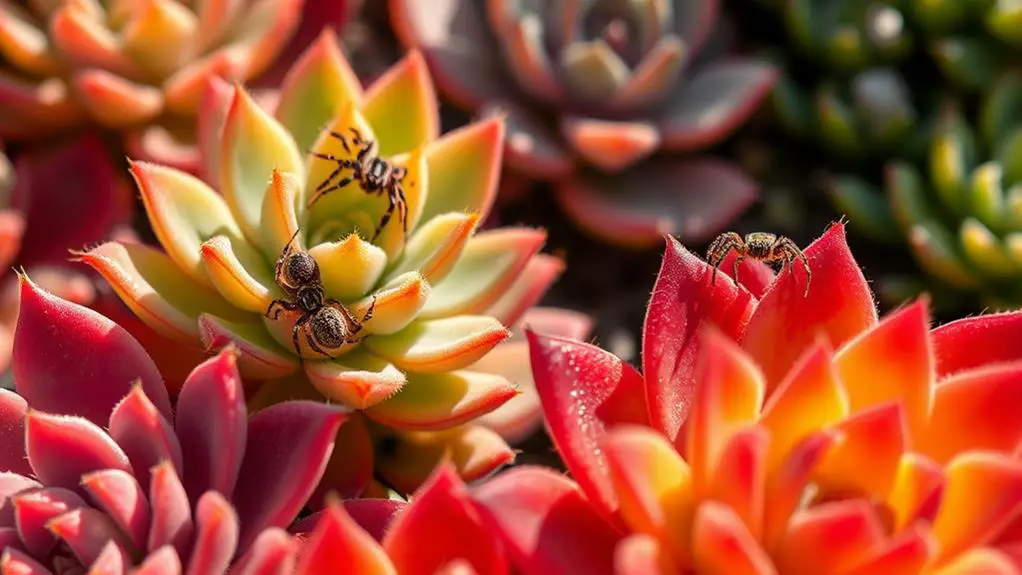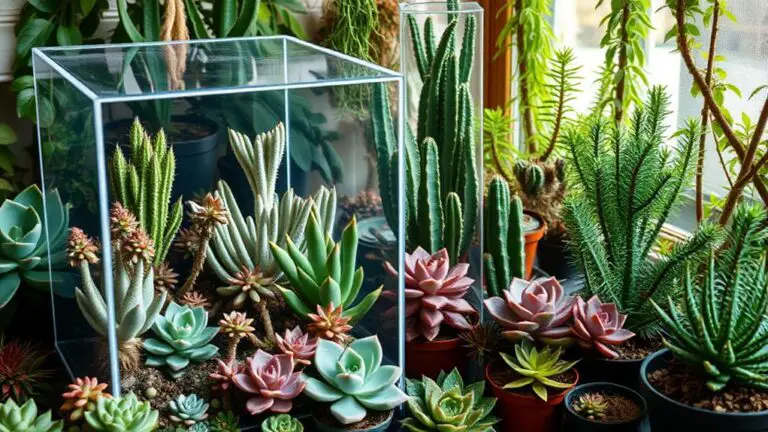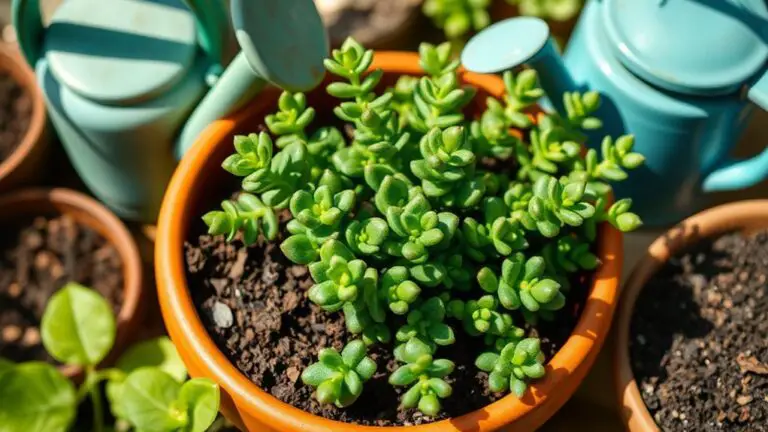Are Jumping Spiders Good for Succulents?
You might be wondering if jumping spiders are beneficial for your succulents. These tiny, agile hunters can actually help protect your plants by preying on common pests like aphids and spider mites. Unlike web-spinning spiders, jumping spiders use their keen eyesight and quick movements to catch their prey, making them efficient pest controllers. But do they pose any risks to your beloved succulents, or could they disrupt the delicate balance of your garden? Before you decide whether to welcome these eight-legged allies, it's important to weigh the benefits against potential drawbacks.
Overview of Jumping Spiders
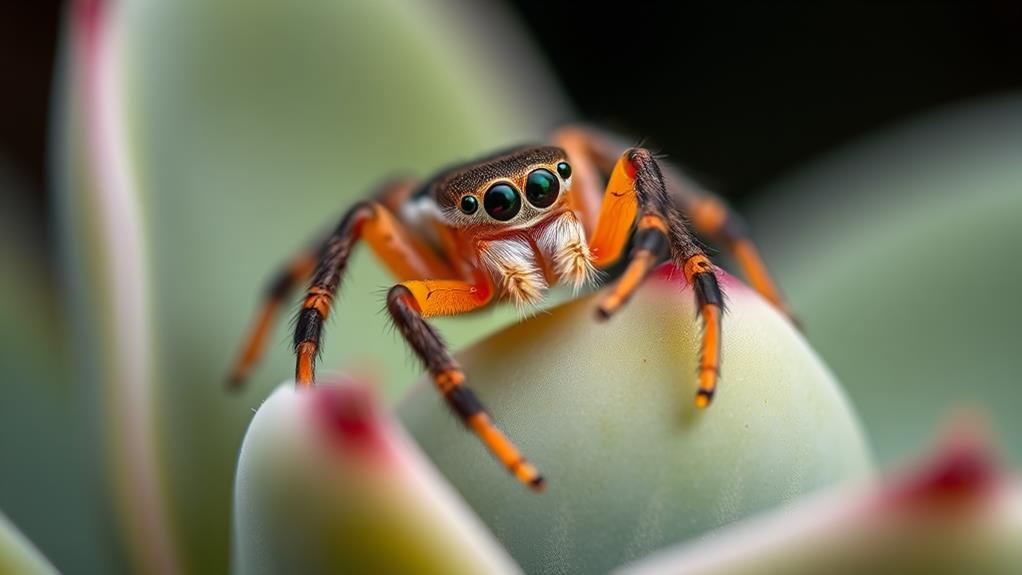
Jumping spiders, belonging to the family Salticidae, are fascinating creatures known for their remarkable agility and jumping abilities. These spiders are typically small, ranging from 1 to 2 cm in length. They possess distinctive large front-facing eyes, which give them exceptional vision. This keen eyesight helps them spot and pounce on prey, making them effective predators.
You'll often find jumping spiders in sunny, dry environments. They thrive in gardens and homes, especially in areas with succulents and cacti. These environments provide them with plenty of hunting opportunities and hiding spots.
Unlike other spiders, jumping spiders don't rely on webs to catch their prey. Instead, they actively hunt, using their vision and agility to sneak up on insects. This hunting style allows them to be effective predators, keeping your succulent garden free from pest insects.
Jumping spiders come in a wide range of colors and patterns, adding an extra layer of interest to your garden. Each species has its own unique personality and hunting style, making them intriguing to observe.
Physical Characteristics
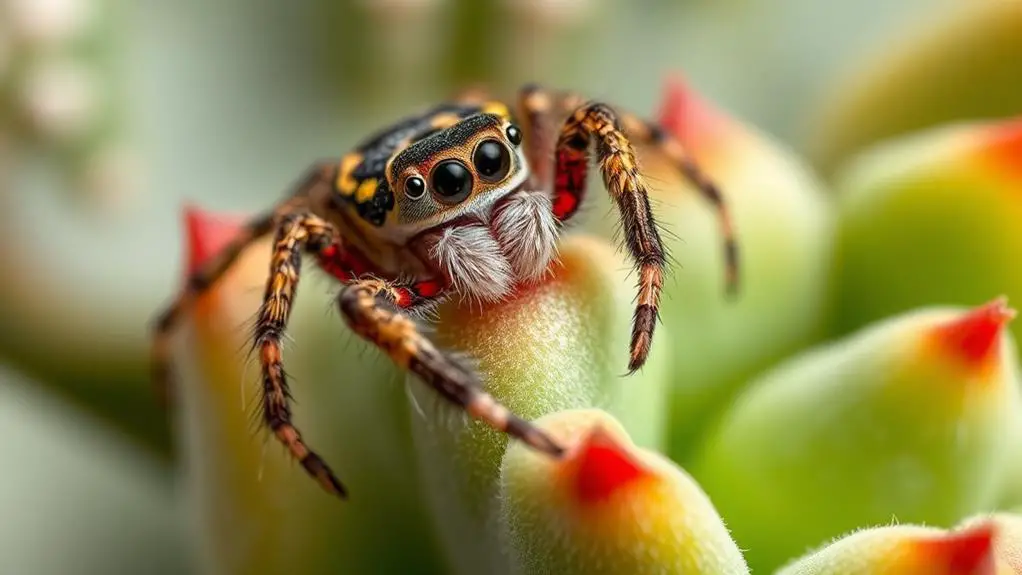
With their small size, typically measuring around 1 to 2 cm, jumping spiders pack a lot of captivating features into their tiny frames. These little guys belong to the Salticidae family and are known for their impressive agility and unique physical characteristics, making them excellent for pest control around your succulents.
Jumping spiders are easy to recognize, thanks to their distinctive large, front-facing eyes. These eyes give them exceptional vision, which is crucial for spotting prey and traversing their environment. Curiously, they can even see ultraviolet light!
You'll also notice that many species have a fuzzy texture. This helps them blend into their surroundings, providing great camouflage. Their appearance varies widely, showcasing an array of colors and patterns. This diversity comes from the approximately 6,380 species identified around the world, so there's no single "typical" look for these spiders.
Here are some key physical characteristics of jumping spiders:
- Small size: Around 1 to 2 cm in length.
- Large, front-facing eyes: Enhance vision and prey detection.
- Fuzzy texture: Aids in camouflage.
- Diverse colors and patterns: Reflect their wide-ranging species.
Their ability to jump up to 50 times their body length is another standout trait, aiding their pest control abilities and making them captivating to observe.
Behavior and Hunting Techniques
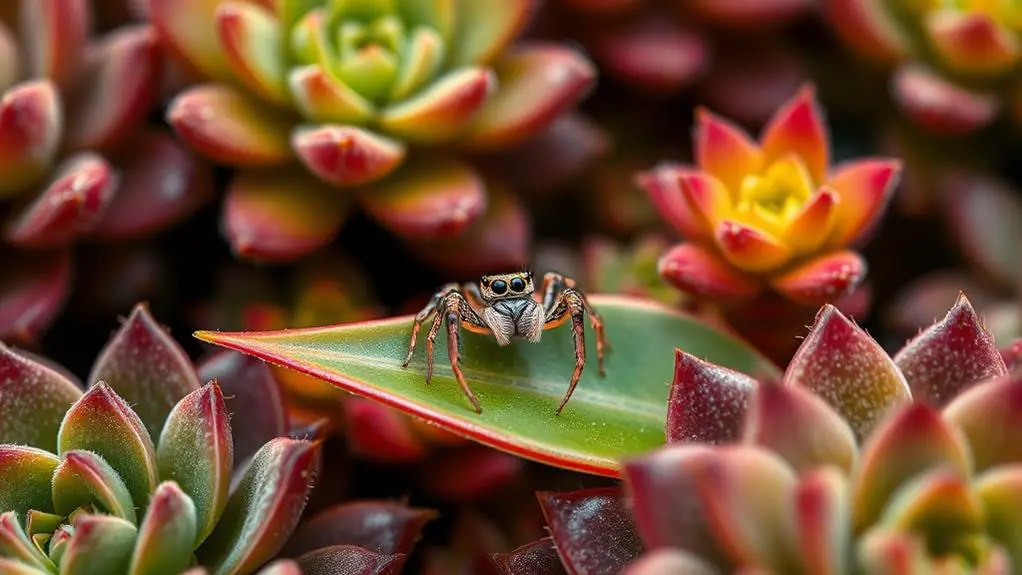
Beyond their enchanting physical traits, the behavior and hunting techniques of jumping spiders are equally fascinating. Jumping spiders are active hunters, relying on their exceptional vision and agility to locate and pounce on prey. They don't use webs to trap insects but instead stalk and ambush their targets. This makes them very efficient predators in your garden.
One of the coolest things about these spiders is their use of silk. They create safety tethers during their jumps, ensuring they don't fall or miss their target. This helps them navigate and catch insects more effectively.
When they find prey, like aphids or spider mites, they use venom to paralyze the insects before consuming them. This is great for your succulents since it reduces pest populations that can damage your plants.
Jumping spiders prefer sunny, dry environments, which matches the habitat needs of many succulent species. This means they can thrive together, creating a natural balance.
Interaction With Humans and Pets
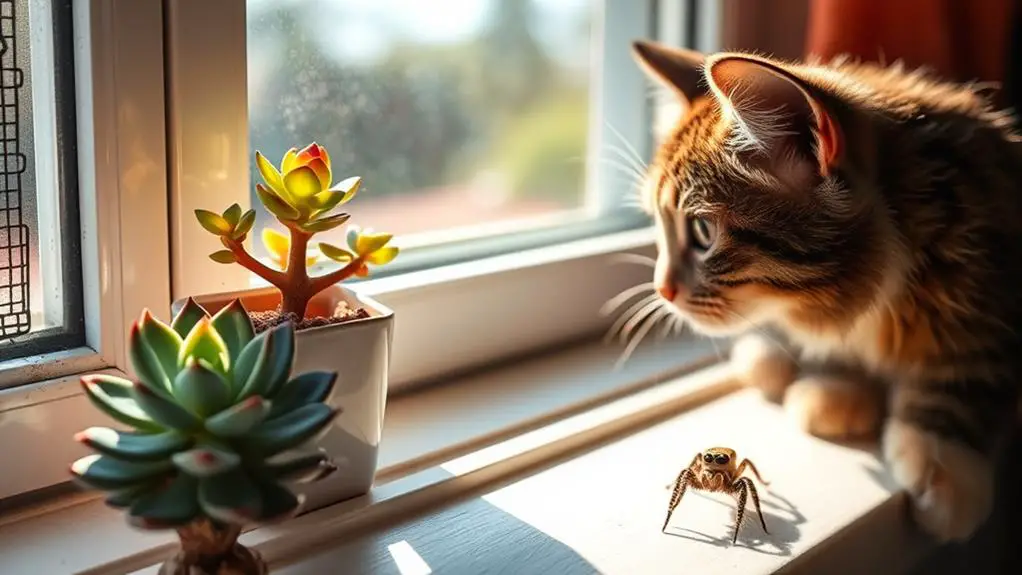
You might be surprised to learn that jumping spiders generally avoid humans and only bite when they feel threatened. This makes them low-risk companions in gardens and homes. Their venom isn't harmful to humans, often resulting in little to no symptoms if a bite does occur. You can feel at ease knowing that these spiders are non-aggressive and prefer to keep their distance.
When it comes to your pets, jumping spiders are equally harmless. They typically steer clear of larger creatures and prefer to remain hidden. This means accidental encounters between your pets and these spiders are unlikely to lead to any danger.
Here's why jumping spiders are good for your home and garden:
- Low-risk companions: They avoid humans and pets, reducing the chance of bites.
- Non-aggressive behavior: They only bite when they feel threatened.
- Harmless venom: Their bites cause little to no symptoms in humans.
- Beneficial presence: They help control pest populations without harming plants or household safety.
Understanding the interaction with humans and pets can help you feel more comfortable about having these little helpers around. Rest assured, they pose no significant threat to your household.
Benefits to Succulents

Jumping spiders can be your succulents' best friends by controlling pests like aphids, spider mites, and gnats.
These tiny predators don't harm the plants; instead, they help them grow healthier by reducing the pest population.
Since they thrive in dry environments, they're perfect for your succulent garden, cutting down the need for chemical pesticides.
Natural Pest Control
Among the most effective natural pest controllers, jumping spiders offer significant benefits to succulents by preying on harmful insects like aphids, spider mites, and gnats. Their hunting behavior involves actively pouncing on prey, which makes them quite effective in managing pest populations without the need for webs.
Using jumping spiders for natural pest control can greatly enhance your gardening experience. Here are some key benefits:
- Eco-friendly gardening: By reducing the need for chemical pesticides, you're promoting a healthier environment for your succulents.
- Healthier ecosystem: Jumping spiders help maintain a balance by targeting pests that can harm your plants.
- Better growth: With fewer pests attacking them, your succulents can grow stronger and more vibrant.
- Easy maintenance: These spiders do the hard work, so you can enjoy your garden with less effort.
Jumping spiders have exceptional vision, allowing them to detect and target small insects effectively. This contributes to a healthier ecosystem for your succulents.
Non-Destructive Behavior
When it comes to safeguarding your succulents, jumping spiders stand out because of their non-destructive behavior. These small but mighty hunters primarily prey on pests like aphids and spider mites, which can harm your succulents. By keeping these pests in check, jumping spiders help maintain the health of your plants without causing any damage themselves.
One of the best things about jumping spiders is that they don't spin webs. Unlike other spiders, they don't create messy webs that could entangle or harm your succulents. Instead, they use silk only to make safety tethers. These tethers let them jump between plants without impacting the plants' health or structure.
Moreover, having jumping spiders in your garden can boost biodiversity. They contribute to a balanced ecosystem that supports the health of your succulents. Since they don't harm plants, they're a beneficial addition to your succulent care routine.
Potential Risks
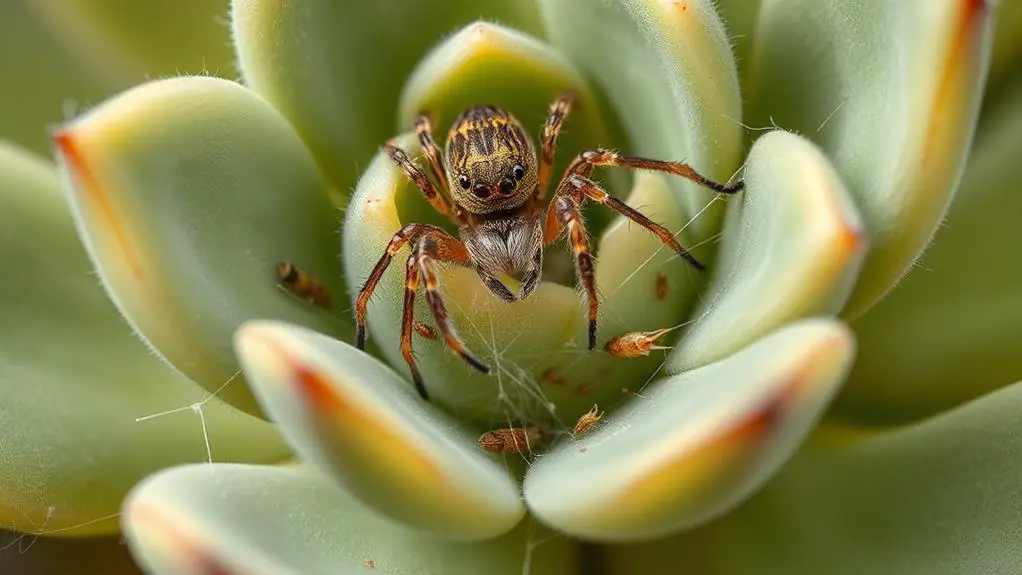
While jumping spiders can be beneficial in controlling pests, they also present several potential risks to your garden's ecosystem. One major concern is resource depletion. These spiders might compete with other beneficial insects for limited food resources, which could disrupt the balance of your local ecosystem.
Here are some specific risks to contemplate:
- Resource Depletion: Overpopulation of jumping spiders in a confined area could lead to a shortage of food, harming both the spiders and your plants.
- Aggressive Behavior: Some species may become aggressive if they feel threatened, posing a risk to other insects and possibly harming your garden's biodiversity.
- Ecosystem Imbalance: By outcompeting other beneficial insects, jumping spiders can disrupt the natural balance of your garden's ecosystem.
- Uncertain Long-term Effects: Limited research exists on how jumping spiders impact plant health over time, making their role in succulent care somewhat uncertain.
It's important to remember that while jumping spiders are useful, they shouldn't be your only pest control method.
Using an integrated approach will help you manage your garden more effectively. By understanding these potential risks, you can make informed decisions to keep your succulents healthy and thriving.
Encouraging Jumping Spiders
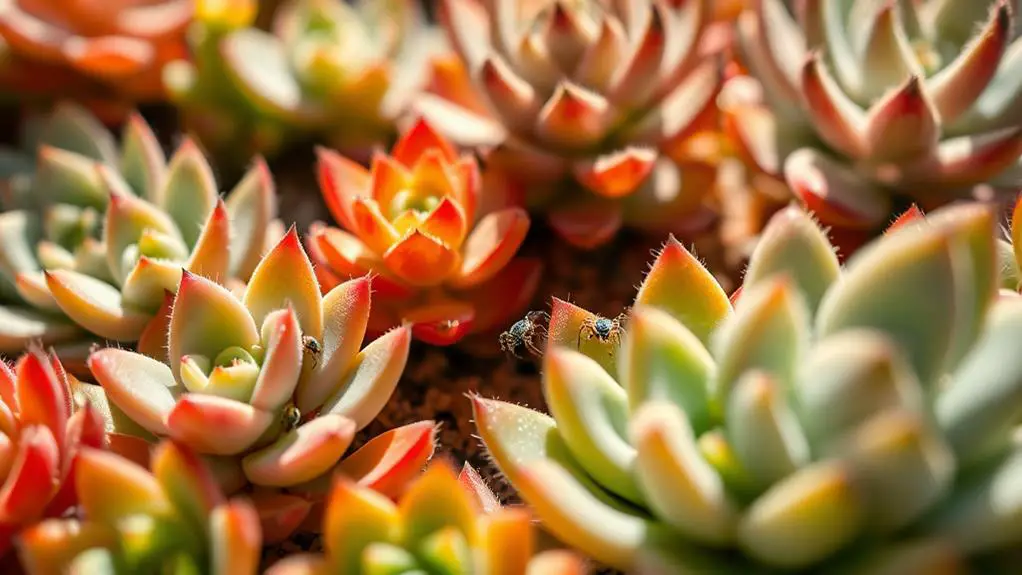
To attract jumping spiders to your succulent garden, start by creating a sunny and dry environment that suits their needs.
Encourage a diverse range of plants and avoid chemical pesticides to keep your ecosystem healthy and welcoming.
You can also add small silk retreats for the spiders, promoting natural pest control and enhancing garden biodiversity.
Attracting Natural Predators
Jumping spiders are a gardener's ally in maintaining healthy succulent gardens. To attract these beneficial predators, you can create an inviting environment that supports their natural behaviors and habitat needs. By doing so, you'll help control pest populations like aphids and spider mites, making your garden thrive.
Here are some simple yet effective tips to encourage jumping spiders:
- Sunny Spots: Jumping spiders love sunny, dry places, just like succulents. Confirm your garden has plenty of sunny areas where these spiders can bask and hunt.
- Diverse Plants: Plant a variety of species to create a more inviting habitat. This diversity can attract a range of insects, providing jumping spiders with plenty of prey.
- Organic Gardening: Avoid chemical pesticides. These can harm jumping spiders. Instead, use organic gardening practices to maintain a safe, healthy environment.
- Shelter: Provide small shelters or leave some natural debris. Jumping spiders use silk to create safety tethers and retreats, which helps them stay in your garden.
Promoting Pest Control
Creating an environment that promotes pest control by encouraging jumping spiders is straightforward and beneficial. These tiny, agile predators are excellent at managing pests that commonly infest succulents, such as aphids, spider mites, and gnats.
Their unique hunting style, which involves pouncing on their prey rather than spinning webs, makes them both efficient and effective at keeping these harmful insects under control.
Jumping spiders have exceptional vision, allowing them to spot and target small pests with precision. By introducing these spiders to your garden, you not only enhance pest management but also foster a balanced ecosystem.
This balanced ecosystem supports biodiversity, which is essential for the overall health of your plants.
Relying on jumping spiders for pest control means you can reduce or even eliminate the need for chemical pesticides, which can be harmful to your succulents and the environment.
These natural predators help maintain healthier succulents, as they actively contribute to managing pest populations without causing any damage to the plants themselves.
Creating Spider-friendly Habitats
Designing a garden that welcomes jumping spiders starts with incorporating a variety of plants, including succulents, to provide them with shelter and food sources.
These spiders thrive in sunny, dry environments, which also happen to be perfect conditions for your succulents. By creating a habitat that meets their needs, you'll encourage jumping spiders to take up residence, benefiting your garden's ecosystem.
To create an ideal habitat, follow these tips:
- Include various plants: Diversity in plant types guarantees a stable food supply and ample hiding spots for spiders.
- Maintain a sunny, dry environment: Both succulents and jumping spiders prefer these conditions.
- Inspect for silk retreats: These small silk structures indicate that spiders are comfortable and thriving.
- Avoid chemical pesticides: These can harm spiders and disrupt the natural pest control they provide.
Regularly check the health of your plants and observe spider activity to guarantee a balanced, thriving habitat.
By avoiding chemical pesticides, you'll protect these beneficial insects. Your succulents and jumping spiders can coexist harmoniously, creating a vibrant and pest-free garden space.
With these steps, you'll support a healthy ecosystem right in your backyard.
Care Tips for Succulents
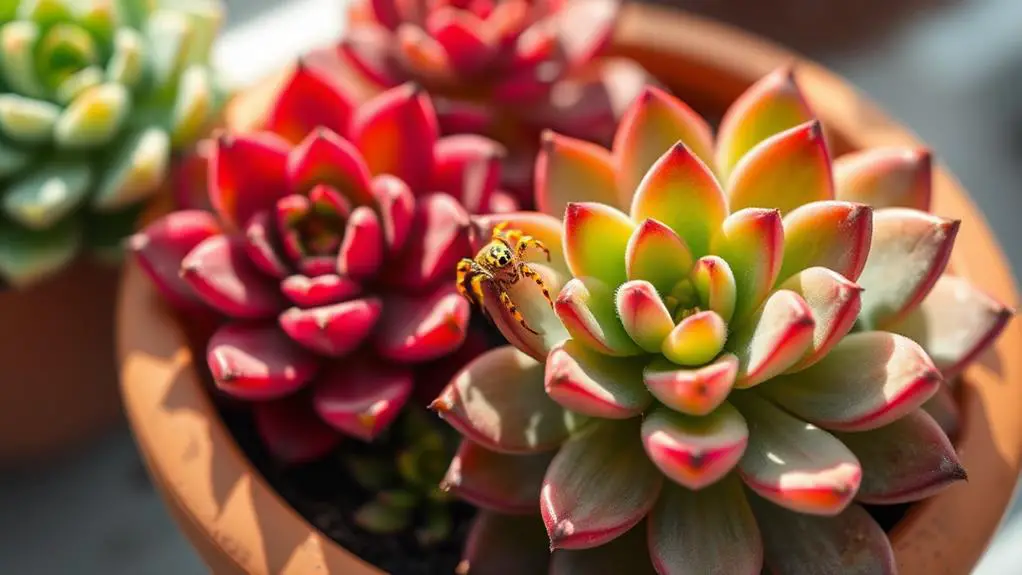
When it comes to caring for succulents, ensuring proper drainage in their pots is essential to prevent root rot. Succulents thrive in dry conditions and can't tolerate standing water. Make sure your pots have drainage holes so excess water can escape. This helps keep the roots healthy.
Water sparingly. Succulents need to dry out completely between watering sessions. Overwatering is a common mistake that can lead to root rot. Wait until the soil is completely dry before giving your succulents a good soak. Remember, it's better to underwater than overwater these hardy plants.
Provide adequate sunlight. Most succulents love bright light or direct sunlight. Place them in a sunny spot where they can soak up those rays. Some varieties can tolerate lower light, but they mightn't flourish as well. If you notice your succulent stretching towards the light, it might need a brighter location.
Regularly inspect your plants for pests and overall health. Look out for any signs of trouble and address them quickly. This helps keep your succulent garden thriving.
Use organic fertilizers to boost growth without introducing harmful chemicals. Happy, healthy succulents will brighten up your space and be a welcoming home for beneficial insects like jumping spiders.
Integrated Pest Management
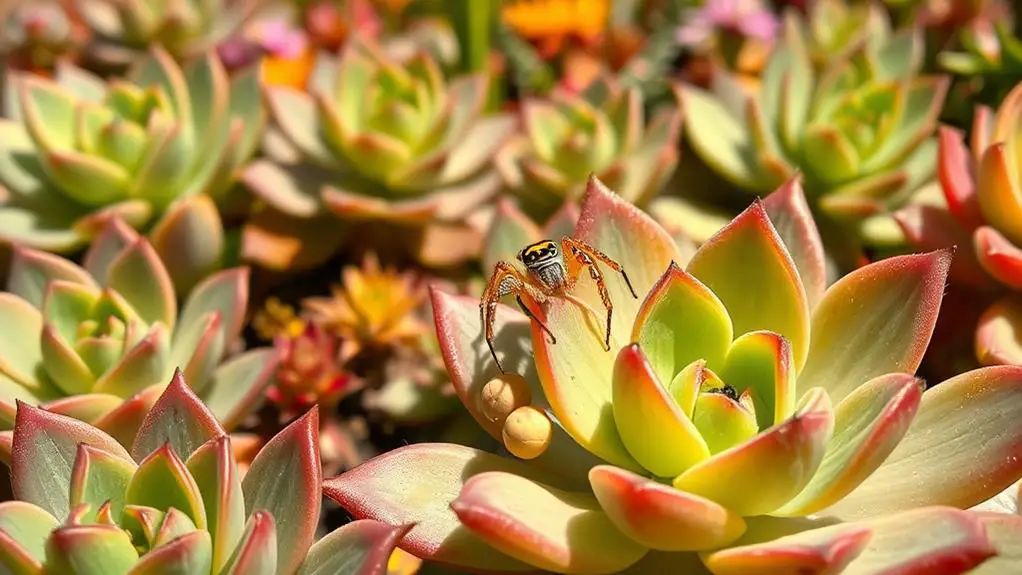
Integrated pest management (IPM) is a smart strategy for keeping your succulent garden healthy and pest-free. By incorporating jumping spiders into your garden, you can effectively manage pests like aphids, spider mites, and gnats.
These tiny hunters are a fantastic addition to your eco-friendly gardening practices. They actively hunt and reduce pest populations without the need for harmful chemicals.
Jumping spiders contribute to a balanced ecosystem by:
- Preying on common succulent pests, keeping their numbers in check.
- Using silk tethers and barriers to enhance their hunting efficiency.
- Promoting natural pest control, reducing the need for chemical pesticides.
- Providing a way to monitor and assess pest management effectiveness.
Their active hunting behavior guarantees that pests are quickly managed, allowing your succulents to thrive.
Encouraging jumping spiders in your garden creates a natural balance, leading to healthier plants and fewer pests. Regularly monitoring their presence helps you understand how well your pest management strategies are working.
Frequently Asked Questions
Are Jumping Spiders Beneficial to Plants?
Yes, jumping spiders are beneficial to plants. They control pests like aphids and spider mites, reducing the need for pesticides. Their minimal silk doesn't harm plants, making them excellent natural allies for maintaining plant health.
Can I Put a Jumping Spider in a Terrarium?
Yes, you can put a jumping spider in a terrarium. They help control pests like aphids and spider mites. Their need for a dry environment matches succulent conditions, creating a balanced ecosystem and promoting plant health.
What Are Jumping Spiders Good At?
Jumping spiders excel at controlling pests like aphids and spider mites. They're great hunters with exceptional vision and agility. Their presence in your garden promotes biodiversity, creating a balanced ecosystem that supports the health of your plants.
Can You Put Live Plants in a Jumping Spider Enclosure?
You can absolutely put live plants in a jumping spider enclosure. They provide shelter and a natural environment. Just choose non-toxic, hardy plants like succulents and guarantee proper drainage to keep both your spiders and plants healthy.
Conclusion
By welcoming jumping spiders into your succulent garden, you'll create a healthier, more vibrant space without relying on harmful pesticides. These tiny hunters will keep pests at bay, ensuring your plants thrive. Don't worry about them harming your succulents or being a nuisance; they're just there to help. So, embrace these beneficial spiders and enjoy the benefits they bring to your garden. Your succulents—and your eco-friendly gardening practices—will thank you!

